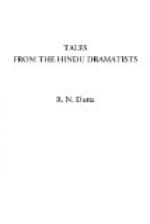MALATI-MADHAVA.
The marriage dress of high-born females described in the sixth act is well worthy of our observation. It consisted of a corset of white silk and a fine red upper garment, besides the usual lower dress, ornaments, and a chaplet of flowers. It has received several modifications since the days of Bhavabhuti.
The sacrifice of good-looking girls, alluded to in the fifth act, was common in his time and other authors allude to it. The seventh story of Dasakumar Charita is just like it, when a prince rescues a princess from a similar Sanyasi and afterwards marries her.
The story of “Malati and Madhava” is one of pure invention. The manners described are purely Hindu without any foreign admixture. The appearance of women of rank in public, and their exemption from any personal restraint in their own habitations, are very incompatible with the presence of Muhammedan rulers. The licensed existence of Buddha ascetics, their access to the great, and their employment as teachers of science, are other peculiarities characteristic of an early date; whilst the worship of Siva in his terrific forms, and the prevalance of the practices of the Yoga, are indications of a similar tendency.
MUDRA RAKSHASA.
It must be acknowledged, that the political code from which the stratagems of Chanakya emanate, exhibits a morality not a whit superior to that of the Italian school; but a remarkable, and in some respects a redeeming principle, is the inviolable and devoted fidelity which appears as the uniform characteristic of servants, emissaries, and friends.
The play is wholly of a political character, and represents a series of Machiavellian stratagems, influencing public events of considerable importance.
The Mudrarakshasa is, in sundry respects, a very unique work in Sanskrit literature. Its plot is not a pure invention, but on the other hand, it is not derived from the usual storehouse of legends on which Sanskrit authors have generally drawn for their materials. It has no female among its prominent dramatis personae, and the business of the play, accordingly, is diplomacy and politics, to the entire exclusion of love. There is, in truth, but one female character, with one little child, introduced into the play, and these are Chandanadasa’s wife and son, who come in at the beginning of the last act. But even their appearance introduces no passages suggestive of tenderness or the purely domestic virtues, but only of sacrifice—a stern sense of duty.
In the minor characters we see the principle of faithfulness to one’s lord, adhered to through good report and evil report. In the more prominent ones, the same principle still prevails, and the course of conduct to which it leads is certainly quite Machiavellian. And all this is brought out in a plot put together with singular skill.




